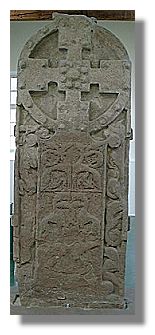The Picts
The Picts are a mystery. The name "Picti" was given by the Roman invaders around 70AD to the tribes living in the Highlands of what was to become Scotland. They left no written records and their language has only come down to us as in the form of some place names in the areas which they inhabited. But they did leave a fantastic legacy of carved stones, many of which have survived. They depict warriors, animals, symbols and - latterly - Christian symbols after the Picts had been converted by Saint Columba and others in the 6th century.
The Picts were not confined to the Highlands, though they had a number of power bases there. But they also inhabited the lower-lying areas of Aberdeen, Angus, Fife and as far as the river Forth. In 685 the Picts defeated an invasion by the king of Northumbria a battle at Dunnichen (also known as Nechtansmere) in Angus. It can be argued that if the Picts had not achieved that victory, the Northumbrians would have over-run much of Scotland and there might never have been a Scottish nation.
The Picts were eventually overcome by the Scots from Dalriada (that is, in Argyll in the west) who were themselves under pressure from the Vikings. Kenneth mac Alpin may have defeated the Picts in battle but around the 9th century they disappear from the historical records.
The Museum
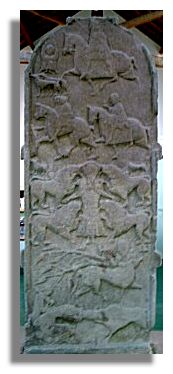 Meigle is a small village on the A94 road from Couper Angus to Forfar. Glamis Castle is just a few miles further on Angus. The collection of around 30 stones were all found in the village, mostly in the churchyard. The museum was originally a school house but was taken over at the end of the 19th century specifically to house the Pictish stones. The museum is only open in the summer.
Meigle is a small village on the A94 road from Couper Angus to Forfar. Glamis Castle is just a few miles further on Angus. The collection of around 30 stones were all found in the village, mostly in the churchyard. The museum was originally a school house but was taken over at the end of the 19th century specifically to house the Pictish stones. The museum is only open in the summer.
At one time, two of the largest Pictish stones stood on each side of the entrance to the churchyard. The stone illustrated here (and above - showing the front of the same stone) was one of these. Standing almost 2.5 metres (over 8 feet) high, it was created in the 9th century and stood on a grassy knoll known as Vanora's Grave. According to local legend, Vanora was Queen Guinevere, wife of King Arthur, who had been abducted by the Pictish King Mordred and held captive near Meigle. When she returned to King Arthur after this enforced infidelity, she was sentenced to death - by being torn apart from wild beasts. The carving shows a robed figure surrounded by four lions. Of course, other experts say that this is a representation of the Bible story of Daniel in the lions den.
There are around 30 carved stones displayed in Meigle. Some are extremely large, others are only fragments. It is thought likely that there are more stones buried in the churchyard. The current building was constructed soon after 1869 (when a fire destroyed the previous church) but this was one of a series of churches dating back to at least the 12th century, all built on the same spot. The presence of so many Pictish cross slabs suggests that a place of worship stood here as far back as the 8th or 9th centuries.
The Carved Stones
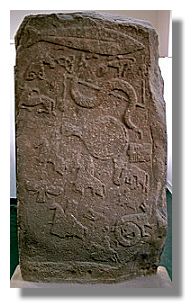
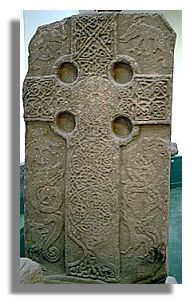 The stones at Meigle are not of the earliest type of Pictish carving but they belong to the period after the Picts had been converted to Christianity. The earliest stone is the one shown here, dating from the late 8th century. However, archaeologists have identified markings on the stone which suggest that it was re-used from a much earlier time, possibly thousands of years.
The stones at Meigle are not of the earliest type of Pictish carving but they belong to the period after the Picts had been converted to Christianity. The earliest stone is the one shown here, dating from the late 8th century. However, archaeologists have identified markings on the stone which suggest that it was re-used from a much earlier time, possibly thousands of years.
Although it clearly has the Christian cross, it is also embellished with a variety of animals, some mythical (including a sea horse) on the front. On the reverse of the same stone, there are a mixture of Pictish symbols (a salmon, dog's head, Pictish beast, serpent, Z-rod and the typical mirror and comb) plus other animals, horsemen, a kneeling camel and a figure representing an angel with outstretched wings. Since there were no camels in Scotland at that time, it was probably copied from an imported artefact.
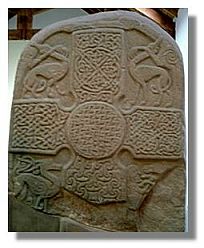 The illustration here is of the upper section of a Pictish cross-slab. At the top are two animals with snouts meeting across the top of the cross. They are being bitten on the throat by two other animals. On the bottom left corner possibly a deer, with an exaggerated set of horns, and in the bottom right corner a Pict can just be seen grappling with another animal.
The illustration here is of the upper section of a Pictish cross-slab. At the top are two animals with snouts meeting across the top of the cross. They are being bitten on the throat by two other animals. On the bottom left corner possibly a deer, with an exaggerated set of horns, and in the bottom right corner a Pict can just be seen grappling with another animal.
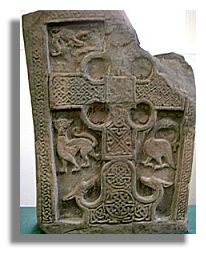 This next example of a Pictish cross-slab has a number of unusual features. The Greek cross has four arm-pits and below is a base with Celtic knots and two animals looking inwards. The animal on the left has bulbous eyes and the bird on the right seems to have a snake in its mouth. On the reverse of this slab (not illustrated here) is part of a man riding a horse.
This next example of a Pictish cross-slab has a number of unusual features. The Greek cross has four arm-pits and below is a base with Celtic knots and two animals looking inwards. The animal on the left has bulbous eyes and the bird on the right seems to have a snake in its mouth. On the reverse of this slab (not illustrated here) is part of a man riding a horse.
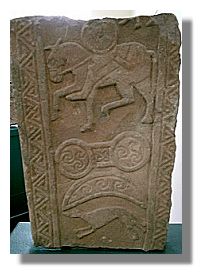
The illustration above is of the middle section of the rear of what was a cross. It was here that the traditional Pictish symbols of old would often appear - in this case, a rider with a shield, a connected double disc, a spiral-filled crescent and a dog with a collar.
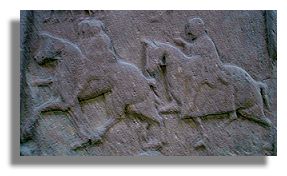 Much of what we know about the Picts comes from carved stones such as these at Meigle and in other parts of Scotland. Clearly they were accomplished horsemen, sometimes with the horses pulling a kind of carriage or, as here, galloping briskly across the countryside in formation.
Much of what we know about the Picts comes from carved stones such as these at Meigle and in other parts of Scotland. Clearly they were accomplished horsemen, sometimes with the horses pulling a kind of carriage or, as here, galloping briskly across the countryside in formation.
